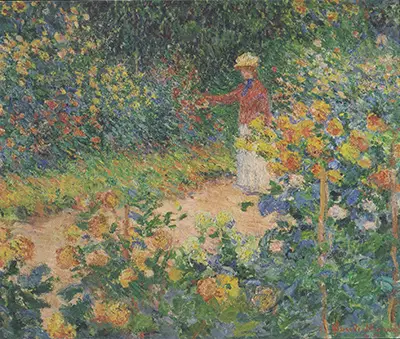The painting was completed from his Giverny estate which he had purchased and redesigned it into a flower garden. His passion for the countryside and his artwork were inseparable.
The picture depicts a woman in the garden picking flowers. A lady in the painting is strolling through the blossoming garden.
It also depicts many colorful flowers in orange, yellow and red. You can see from the picture the harmony created after he used the blue-violet and green pigments to represent leaves. Behind the flowers, we can see the light brown path and background of bright, vibrant vegetation.
Additionally, the lady is placed at right side of the canvas. She is wearing a long white dress, a red blouse top with a purple sleeve, and a cowboy like a wicker hat. Even though it is unclear, we can presume that she was holding a basket and is reaching out to pick flowers from the bush. She was not just picking flowers she seems to be taking a keen look at the flowers.
Monet painted his artwork with short and long loose strokes with pure pigmentation. Monet painted an opulent wealth of flowers, shrubs, and trees. From the painting, we can see that there is no horizon which means brings out the impressionist intention that harmonizes the depth and the surface.
Monet technique is incredible, he painted light green bushes just as he was painting yellow and violet-blue flowers, and red all the way to the top edges of the canvas.
In the garden painting draws inspiration from impressionists point of view. The modern painters loved nature and felt the need to leave big cities and take their artistry to the countryside. Therefore, this went against the contemporary consumerism. In the garden was inspired by the best of Japanese art that was in Europe at the time.
Japanese paintings had a way of capturing the daily life of ordinary people uniquely. This approach went against the classical art of western civilization. Foreign cultures heavily inspired Monet, and his paintings and structural changes at Giverns portray this. That is why he built a Japanese bridge over the pond, and his paintings depicted the same.
Monet disliked the formal landscape of his main pathway. Thus he thinned the cypress trees and the stands of spruce that bordered the walk. In contrast to ‘in the garden painting,’ we can see the trees and spruce are taller and are not thinned. The dense bed of spruce was fuschia, nasturtiums, and dahlias which bloomed thought out the summer months. The reason why Monet left the bed of spruce and trees to grow tall is probably that his wife Alice had protested about thinning this wonderful creation of nature.
Related works to in the garden include ‘Young Girl in the Garden at Giverny 1888’, ‘Pathway in Monet's Garden at Giverny 1900’, ‘Pathway in Monet's Garden at Giverny 1901-1902’, and ‘The Garden at Giverny 1922-1924’, among many other paintings.


